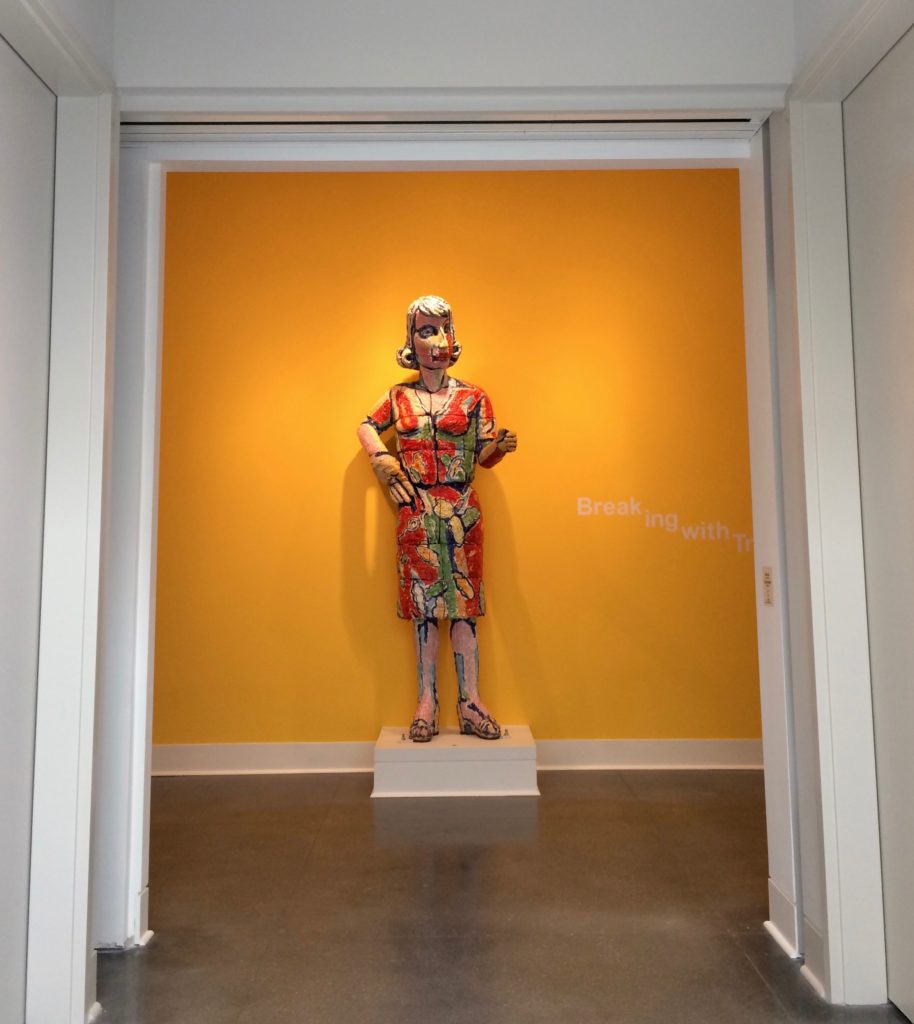By Jan Worth-Nelson
What does art—and a major investment in making, acquiring and exhibiting it–mean to the City of Flint?
Organizers of the weekend celebration and ribbon cutting for the opening of the 20,000-square-foot, $14 million Contemporary Crafts Wing and three new studios at the Flint Institute of Arts assembled a range of local luminaries, clerics, and politicians to offer answers.
Their responses to the rhetorical moment were colorful and varied, delivered in the form of chants, a sacred song, congratulations, plaudits, thanks to donors, and tributes to Flint’s working class.
They suggested that “art is not expendable,” and needs to be available to all children. They asserted that completion of work at the FIA was a sign of the city’s resilience, as U.S. Senator Debbie Stabenow stated, and of a positive and inspirational story about Flint that is “unfolding before our eyes,” as Lt. Governor Brian Calley put it.
Of course, the main point of the day was to celebrate the FIA, in its 90th year the second largest art museum in the state of Michigan, its art school the fifth largest in-house art museum school in the country – a family friendly place, FIA Executive Director John Henry emphasized, where “everyone can learn while having fun.” (More about the story of the newest acquisitions and the expansion available here.)
‘The significance of connecting works in the collection to the hands-on studio experience has always been central to our mission,” Henry said, connecting to Flint’s history as a “maker” place from its early carriage-making days.
In that spirit, the actual “ribbon cutting” involved a skein of hot glass pulled from an oven in the new “Hot Shop” and quickly stretched and then sliced with scissors by Ridgway White, president of the C.S. Mott Foundation, as glass programs manager Brent Swanson assisted. The action was conveyed by video remotely from the Hot Shop to the waiting crowd in the FIA Theater.
From at least one presenter, comments offered by C.S. Mott Foundation CEO William White, Ridgway White’s father, were warmly personal and a family affair. He cited his late wife Claire’s fascination with the FIA from childhood on, and how she made clay dragons in an FIA class with Flint personage Bill Ballenger, one of which Ballenger said he still has.

A Flint dynasty celebrating the FIA in the new “Hot Shop” (from left) William White, CEO of the C.S. Mott Foundation; wife Louise Hartwell; grandson Daniel, son Ridgway White, president of the C.S. Mott Foundation; grandson Samuel; daughter-in-law Shannon White; and daughter Tiffany Lovett, president of the Isabel Foundation (Photo by Jan Worth-Nelson)
White noted the presence of his California daughter, Tiffany Lovett, president of the Isabel Foundation named for her grandmother, the wife of Harding Mott. The Isabel Foundation acquired the Sherwin and Shirley Glass glass collection which was the catalyst for the FIA’s expansion.
The Mott Foundation gave a “lead gift” of $8.5 million for the project, and Henry said there were “hundreds” of other donors, many of whom had sent representatives to the opening ceremony in the FIA theater.
In addition to Stabenow, U.S. Senator Gary Peters spoke, as did the FIA President of the Board, Tbomas Mitchell. Representatives from the Corning Museum of Glass in New York and in Toledo were recognized, as well as representatives from the Atlanta furniture company founded by Sherwin Glass, whose collection with his wife Shirley started it all.
Mayor Karen Weaver was not present and her representative, Interim City Administrator Steve Branch, did not speak. But while city officials may have been in short supply, religious leaders were present, and the ceremony opened with a lineup of six representatives of the city’s religious diversity.
Ambarish Sharma, a priest at the Kasi Sri Viswanatha Hindu temple in Flint Township, offered a prayer song, a chant, ending with a simple, “Thank you.”

Entrance to the new Dr. Robert and Deanna Harris Burger ceramics gallery, one of the new spaces carved out for the Contemporary Crafts Wing. The stoneware piece is Answering Woman, 1988-2004 by American artist Viola Frey, b.1933 (photo by Jan Worth-Nelson)
Dr. Mohammed Saleem, president of the Flint Islamic Center, offered a prayer beseeching the Creator to “bring our hearts together with love so that we can love each other and live in peace.”
The saving power of beauty
Rev. Freelon Threlkeld of Faith Baptist Temple called for rejoicing, while noting, “Yes, some of us are suffering, but you are God of all gods, you know what’s going on, and you have the power to use it that this city may become a great city,” one in which, he said, people will become better people, and serve each other, with the FIA “reaping great things.”
Quoting Russian writer Theodor Dovstoevsky, Father James Mangan of St. Matthew’s Catholic Church suggested “The world will be saved by beauty.” He said the quote hints at “what many actually perceive as beauty’s damning weakness – it’s not very useful — and yet, this is where its saving power lies. Life is more than just surviving.”
He then sang “Regina Caeli Laetare Allelulia,” Queen of Heaven rejoice, he is risen, pray for us to God.
Unique Jewish associations with glass
Steven C. Low, executive director of the Flint Jewish Federation, noted the Jewish experience and association with glass has been unique, in both celebration and sorrow. He said glassmaking was an ancient Jewish tradition, and that ancient Greek glassmakers once went to France to learn glassmaking in “the Jewish style” from the reputed 400 Jewish glassmakers said to work there.

Dr. Robert and Deanna Harris Burger, about to visit the gallery named for them for the first time–with artist and FIA Art School faculty member Guy Adamec and FIA Director of Development and artist Kathryn Sharbaugh (Photo by Jan Worth-Nelson).
He cited Nov. 10, 1938, known as Kristallnacht, when the windows of Jewish businesses were shattered in Germany – the beginning of the Holocaust. He noted also the use of glass in joyous occasions – the crushing of the glass at weddings—remembering sad times in times of joy, the fragility of all human relationships, and noting to laughter, “some say it will be the last time the husband will get to put his foot down.”
Remembering the laborers
Pastor Dan Scheid of St. Paul’s Episcopal chose to celebrate people he said might be overlooked: “the skilled trades and labor of those who built this place – carpenters, bricklayers, pipefitters, plumbers, roofers, tilers – everything that it takes to support the insititution.” Without their work, he said, “our common life would crumble.” (Executive Director Henry later noted the FIA employs a staff of 109, many of whom fall into skilled trades categories and not all of whom could be individually named.)
Michigan Lieutenant Governor Brian Calley may have captured the tagline of the day. After celebrating recent downtown improvements from the removal of the Hamilton Dam to the Educare Center to the Ferris Wheel innovation incubator as a marker of economic development, he said, “This city is on a roll,” adding, “It’s the easiest city in America to fall in love with.”
More information about visiting the Flint Institute of Arts, 1120 E. Kearsley St., is available at flintarts.org or at 810-234-1695.
Banner image: Tulip Panel, 2003, by Kimiake Higuchi, Japanese, b. 1948.
EVM Editor Jan Worth-Nelson can be reached at janworth1118@gmail.com.


You must be logged in to post a comment.